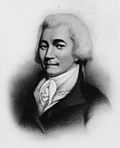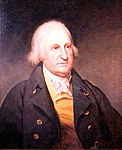1796–97 United States Senate elections
From Wikipedia, the free encyclopedia
The 1796–97 United States Senate elections were held on various dates in various states. As these U.S. Senate elections were prior to the ratification of the Seventeenth Amendment in 1913, senators were chosen by state legislatures. Senators were elected over a wide range of time throughout 1796 and 1797, and a seat may have been filled months late or remained vacant due to legislative deadlock.[1] In these elections, terms were up for the senators in Class 1.
| |||||||||||||||||||||||||
11 of the 32 seats in the United States Senate (plus special elections) 17 seats needed for a majority | |||||||||||||||||||||||||
|---|---|---|---|---|---|---|---|---|---|---|---|---|---|---|---|---|---|---|---|---|---|---|---|---|---|
| |||||||||||||||||||||||||
 Results: Federalist hold Federalist gain Dem-Republican hold Legislature failed to elect | |||||||||||||||||||||||||
| |||||||||||||||||||||||||
They coincided with John Adams's election as President. The ruling Federalist Party gained one seat.
Results summary
Senate party division, 5th Congress (1797–1799)
- Majority party: Federalist (22)
- Minority party: Democratic-Republican (9)
- Vacant: 1 (later filled by Democratic-Republican)
- Total seats: 32
Change in composition
Summarize
Perspective
Before the elections
After the August 2, 1796 admission of Tennessee.
| DR6 | DR5 | DR4 | DR3 | DR2 | DR1 | ||||
| DR7 | DR8 | DR9 N.Y. Ran |
DR10 Tenn. Ran |
DR11 Va. Unknown |
V2 | V1 | F19 Vt. Resigned |
F17 R.I. Ran |
F16 Pa. Ran |
| Majority → | |||||||||
| F7 | F8 | F9 | F10 | F11 | F12 Conn. Ran |
F13 Del. Ran |
F14 Md. Ran |
F18 Mass. Resigned |
F15 N.J. Ran |
| F6 | F5 | F4 | F3 | F2 | F1 | ||||
Results of the regular elections
| DR6 | DR5 | DR4 | DR3 | DR2 | DR1 | ||||
| DR7 | DR8 | DR9 Va. Re-elected |
V2 Tenn. DR Loss |
V2 | V1 | F19 Vt. Hold |
F17 R.I. Re-elected |
F16 Pa. Re-elected |
F20 N.Y. Gain |
| Majority → | |||||||||
| F7 | F8 | F9 | F10 | F11 | F12 Conn. Re-elected |
F13 Del. Re-elected |
F14 Md. Re-elected |
F18 Mass. Hold |
F15 N.J. Re-elected |
| F6 | F5 | F4 | F3 | F2 | F1 | ||||
| Key |
|
|---|
Race summaries
Summarize
Perspective
Except if/when noted, the number following candidates is the whole number vote(s), not a percentage.
Special elections during the 4th Congress
In these special elections, the winners were seated before March 4, 1797; ordered by election date.
| State | Incumbent | Results | Candidates | ||
|---|---|---|---|---|---|
| Senator | Party | First elected | |||
| Georgia (class 2) |
George Walton | Federalist | 1795 (Appointed) | Appointee retired when successor elected. New senator elected February 20, 1796. Democratic-Republican gain. |
|
| Connecticut (class 1) |
Oliver Ellsworth | Federalist | 1788 | Incumbent resigned to become Chief Justice of the United States. New senator elected May 12, 1796. Federalist hold. |
|
| Massachusetts (class 1) |
George Cabot | Federalist | 1790 | Incumbent resigned June 9, 1796. New senator elected June 11, 1796 on the second ballot. Federalist hold. Successor also elected the same day to the next term, see below. |
|
| Massachusetts (class 2) |
Caleb Strong | Federalist | 1788 | Incumbent resigned June 1, 1796. New senator elected June 11, 1796 on the second ballot. Federalist hold. |
|
| Connecticut (class 3) |
Jonathan Trumbull Jr. | Federalist | 1794 or 1795 | Incumbent resigned June 10, 1796, to become Lieutenant Governor of Connecticut. New senator elected October 13, 1796. Federalist hold. |
|
| Vermont (class 1) |
Moses Robinson | Democratic- Republican |
1791 (New state) | Incumbent resigned October 15, 1796. New senator elected October 18, 1796. Federalist gain. Winner also elected the same day to the next term; see below. |
|
| New York (class 3) |
Rufus King | Federalist | 1789 | Incumbent resigned May 23, 1796, to become U.S. Minister to Great Britain. New senator elected November 9, 1796. Federalist hold. |
|
| New Jersey (class 2) |
Frederick Frelinghuysen | Federalist | 1792 or 1793 | Incumbent resigned November 12, 1796. New senator elected November 12, 1796. Federalist hold. |
|
| Maryland (class 1) |
Richard Potts | Federalist | 1793 (special) | Incumbent resigned October 24, 1796. New senator elected November 28, 1796. Federalist hold. Successor also later elected to the next term; see below. |
|
| South Carolina (class 2) |
Pierce Butler | Democratic- Republican |
1789 | Incumbent resigned October 25, 1796. New senator elected December 8, 1796. Democratic-Republican hold. |
|
Races leading to the 5th Congress
In these regular elections, the winner was seated on March 4, 1797; ordered by state.
All of the elections involved the Class 1 seats.
| State | Incumbent | Results | Candidates | ||
|---|---|---|---|---|---|
| Senator | Party | First elected | |||
| Connecticut | James Hillhouse | Federalist | 1796 (special) | Incumbent re-elected in 1797. |
|
| Delaware | Henry Latimer | Federalist | 1795 (special) | Incumbent re-elected January 6, 1797. |
|
| Maryland | John Eager Howard | Federalist | 1796 (special) | Incumbent re-elected December 9, 1796. |
|
| Massachusetts | George Cabot | Federalist | 1790 | Incumbent resigned June 9, 1796. New senator elected June 11, 1796 on the third ballot. Federalist hold. Winner also elected to finish the current term; see above. |
|
| New Jersey | John Rutherfurd | Federalist | 1790 | Incumbent re-elected in 1796. |
|
| New York | Aaron Burr | Democratic- Republican |
1791 | Incumbent lost re-election. New senator elected January 24, 1797. Federalist gain. |
|
| Pennsylvania | James Ross | Federalist | 1794 (special) | Incumbent re-elected February 16, 1797. |
|
| Rhode Island | Theodore Foster | Federalist | 1790 | Incumbent re-elected in 1797. |
|
| Tennessee | William Cocke | Democratic- Republican |
1796 | Legislature failed to elect. Democratic-Republican loss. Incumbent later appointed to continue term.[12] |
None |
| Vermont | Moses Robinson | Democratic- Republican |
1791 (new state) | Incumbent resigned October 15, 1796. New senator elected October 18, 1796. Federalist gain. Winner also elected to finish the current term, see above. |
|
| Virginia | Stevens Mason | Democratic- Republican |
1794 (special) | Incumbent re-elected November 29, 1796. |
|
Special elections during the 5th Congress
In these special elections, the winners were elected after the March 4, 1797 beginning of the next Congress.
| State | Incumbent | Results | Candidates | ||
|---|---|---|---|---|---|
| Senator | Party | First elected | |||
| Tennessee (class 1) |
William Cocke | Democratic- Republican |
1796 | Interim appointee lost re-election. New senator elected September 26, 1797. Democratic-Republican hold. |
|
| Tennessee (class 2) |
William Blount | Democratic- Republican |
1796 | Incumbent expelled July 8, 1797.[15] New senator elected September 26, 1797. Democratic-Republican hold. |
|
| Vermont (class 1) |
Isaac Tichenor | Federalist | 1796 (special) | Incumbent resigned October 17, 1797, to become Governor of Vermont. New senator elected October 17, 1797. Federalist hold. |
|
| Rhode Island (class 2) |
William Bradford | Federalist | 1793 | Incumbent resigned in October 1797. New senator elected November 13, 1797. Federalist hold. |
|
| Maryland (class 3) |
John Henry | Federalist | 1788 | Incumbent resigned July 10, 1797, to become Governor of Maryland. New senator elected December 8, 1797. Federalist hold. |
|
Connecticut
Connecticut (regular)
This section needs expansion. You can help by adding to it. (September 2020) |
Connecticut (special, class 1)
This section needs expansion. You can help by adding to it. (September 2020) |
Connecticut (special, class 3)
This section needs expansion. You can help by adding to it. (September 2020) |
Delaware
This section needs expansion. You can help by adding to it. (September 2020) |
Georgia (special)
This section needs expansion. You can help by adding to it. (September 2020) |
Maryland
Summarize
Perspective
Maryland (special, 1796)
This section needs expansion. You can help by adding to it. (November 2022) |
| ||||||||||||||||
80 members of the Maryland General Assembly | ||||||||||||||||
|---|---|---|---|---|---|---|---|---|---|---|---|---|---|---|---|---|
| ||||||||||||||||
John Eager Howard won election to fill the seat vacated by Richard Potts by an unknown number of votes, for the Class 1 seat.[17]
Maryland (regular)
This section needs expansion. You can help by adding to it. (November 2022) |
| ||||||||||||||||
80 members of the Maryland General Assembly | ||||||||||||||||
|---|---|---|---|---|---|---|---|---|---|---|---|---|---|---|---|---|
| ||||||||||||||||
John Eager Howard won re-election over Richard Sprigg Jr. by an unknown number of votes, for the Class 1 seat.[18]
Maryland (special, 1797)
This section needs expansion. You can help by adding to it. (November 2022) |
| ||||||||||||||||
80 members of the Maryland General Assembly | ||||||||||||||||
|---|---|---|---|---|---|---|---|---|---|---|---|---|---|---|---|---|
| ||||||||||||||||
James Lloyd won election over William Winder by a margin of 1.12%, or 1 vote, for the Class 3 seat.[19]
Massachusetts
Massachusetts (regular)
This section needs expansion. You can help by adding to it. (September 2020) |
Massachusetts (special, class 1)
This section needs expansion. You can help by adding to it. (September 2020) |
Massachusetts (special, class 2)
This section needs expansion. You can help by adding to it. (September 2020) |
New Jersey
New Jersey (regular)
This section needs expansion. You can help by adding to it. (September 2020) |
New Jersey (special)
This section needs expansion. You can help by adding to it. (September 2020) |
New York
New York (regular)
This section needs expansion. You can help by adding to it. (September 2020) |
New York (special)
This section needs expansion. You can help by adding to it. (September 2020) |
Pennsylvania
This section needs expansion. You can help by adding to it. (September 2020) |
Rhode Island
Rhode Island (regular)
This section needs expansion. You can help by adding to it. (September 2020) |
Rhode Island (special)
This section needs expansion. You can help by adding to it. (September 2020) |
South Carolina (special)
This section needs expansion. You can help by adding to it. (September 2020) |
Tennessee
Tennessee (initial)
Tennessee became a state June 1, 1796 and elected its new senators August 2, 1796.
Tennessee (special, class 1)
The term of the initially-elected senator, Democratic-Republican William Cocke, ended March 3, 1797 and the Tennessee legislature failed to elect a senator for the new term. The Governor of Tennessee, therefore, appointed Cocke to begin the term, pending a special election. Cocke, however, lost that October 6, 1798 special election to Democratic-Republican Andrew Jackson.
Tennessee (special, class 2)
Democratic-Republican William Blount was expelled July 8, 1797 for conspiracy with the Kingdom of Great Britain. Democratic-Republican Joseph Anderson was elected September 26, 1797 to finish Blount's term.
Vermont


Incumbent Democratic-Republican Moses Robinson resigned October 15, 1796.
Federalist Isaac Tichenor was elected October 18, 1796, both to finish Robinson's term and to the new term that would begin March 4, 1797. However, Tichenor resigned just one year later, October 17, 1797, to become Governor of Vermont. Federalist Nathaniel Chipman was then elected October 17, 1797, to finish the term.
Vermont (special, 1796)
This section needs expansion. You can help by adding to it. (September 2020) |
Vermont (regular)
This section needs expansion. You can help by adding to it. (September 2020) |
Vermont (special, 1797)
This section needs expansion. You can help by adding to it. (September 2020) |
Virginia
This section needs expansion. You can help by adding to it. (September 2020) |
See also
References
Wikiwand - on
Seamless Wikipedia browsing. On steroids.

